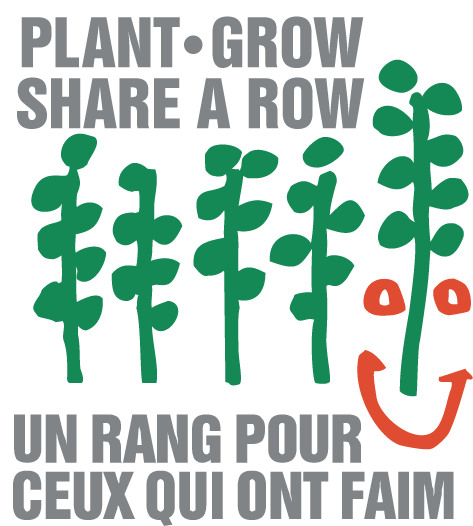
STEP BY STEP: STARTING YOUR OWN
PLANT • GROW • SHARE A ROW CAMPAIGN
Used with permission from the "Plant a Row for the Hungry" campaign of the Garden Writers Association of America
STEP 1: Enlist a Network
The success of a Plant • Grow • Share a Row campaign depends on getting the local gardening community pledged to donate fresh vegetables, fruit and herbs to food banks and/or soup kitchens in need. Publicity is what makes it work.
The first step in creating a campaign is to recruit a group of volunteers who can make it happen. The essential components are:
Local Coordinator to recruit the network and run the campaign, a person with connections to the gardening community.
Recipient Representative to help motivate the network, the media and the donors. Look for a staffer from a food bank, soup kitchen or shelter eager to help you campaign. (The Plant • Grow • Share a Row hotline: 1-877-571-GROW can help find local groups serving the hungry.)
Events Organizer to arrange the PAR "kick-off" day and site, distributing starter kits and brochures and to plan the closing harvest event. Look to your local composting facility, gardening centres and other members of the "growing" industries for help in staffing this very big job.
Produce Organizer to arrange for drop-off and collection sites for the produce and to record pledges and donations from soup kitchens. Look for a dynamic person connected to Master Gardeners, community gardens, garden clubs, botanic gardens, arboreta and similar groups.
Publicist to create stories about the campaign, someone who can enlist all media in supporting the Plant a Row • Grow a Row campaign from kick-off through the growing season and all the way to the harvest "event." It's a job for a person with media connections.
STEP 2: Motivate the Group
Motivation is everything. Recording donations is important. You can help alleviate hunger in your community by motivating your network and, through them, neighbourhood gardeners and gardening organizations.
To get started, try for a planning session at least 10 to 12 weeks before the planting season.
Next, ask your local food bank to describe conditions in your community, the produce wanted and how to prepare it. Then, discuss the tasks ahead:
Produce Organizer: The challenges are identifying drop-off sites for donations; locating people to help with collections; setting up procedures to record and report donations; locating other sources of produce if donations are slow.
Events Organizer: The first job is fixing a date and site for the kick-off and harvest and producing starter kits. These can include a Plant • Grow • Share a Row brochure specific to your community, row markers and modest freebies potentially donated by local garden groups and suppliers - such as a seed packet, a seedling for planting.
STEP 3: Communicate All Season Long
Publicist: The challenge is keeping the Plant • Grow • Share a Row campaign before the public from pre-launch to harvest party. It means enlisting media contacts and feeding them news breaks and potential stories all season long.
The first task is to announce the campaign to your contacts as soon as you know the kick-off day and site. To build attendance for the kick-off, ask them to publish the news and update with mentions of gardeners and garden groups joining the campaign as well as news of the public service announcements. Use your creativity in creating positive events and messages of encouragement and involvement!
Suggest a feature on the produce soup kitchens can best use and how to prepare it. Arrange a "first donation" photo op in a soup kitchen with staffers setting a table with produce and flowers donated by a garden club. Ask your contacts to send a photographer to the kick-off party and provide them with reports of those involved.
Throughout the growing season, help your media contacts keep the campaign before the public by suggesting news breaks and articles that include reminders of the produce wanted and how to become involved. Ask for regular, preferably, weekly, publication of the donations received and the addresses of drop-off sites. Provide leads about human interest stories - how youth, seniors, businesses and others are participating in Plant • Grow • Share a Row.
STEP 4: Celebrate the Harvest
Starting at mid-season, enlist the media in building to the harvest party. Establish a cut-off date for recording donations. Offer your contacts offbeat story ideas: a donated zucchini tracked through the food bank distribution system; run a contest to see who donates the most; give editors photos of kids picking apples to donate, seniors hoeing, a family loading the car to deliver produce.
As the garden season peaks, the weekly total will climb dramatically; so, don't give up on reporting the totals. It takes a paper, radio or TV host very little space to report climbing totals.
Wrap up the campaign at the cut-off date with a harvest party. It can be as simple as a gathering to load the last produce at a community garden, anything upbeat that says "thanks" to the network members, contributors and media. Invite a celebrity to make a statement on the achievements and the importance of this community initiative. Ask your media contacts to publish it. Make sure you connect with the national organizers (1-877-571-GROW) to report your community's total achievements. Congratulate everyone on their generosity and announce a starting date for Plant • Grow • Share a Row!

